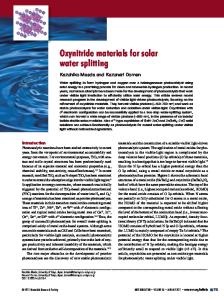Oxynitride Glasses
- PDF / 4,014,135 Bytes
- 6 Pages / 604.8 x 806.4 pts Page_size
- 34 Downloads / 339 Views
glasses. 9 Those experiments show that nitrogen bonding in the glass is similar to that of nitrogen in Si3N4. In other words, the spectroscopic m e a s u r e m e n t s show nitrogen is crosslinked in the glass structure by bonding to three silicons as had been suggested earlier. Figure 1 compares the standard two-dimensional projection of a random-network silicate glass with one in which about one out of every seven bivalent oxygens has been substituted by trivalent nitrogen (a typical level for oxynitride glasses). Thus, oxynitride glasses are interesting to the materials scientist on two counts. Conceptually, they are good tests of theories of glass structure because they permit compositional and structural variation in the anion subnetwork, which otherwise is difficult to achieve. On a more practical level, nitrogen substitution is a means for varying glass properties that is different from ordinary cation substitution and, thus, is yet another synthetic technique in the glass scientist's bag of tricks.
Figure 1a. Schematic two-dimensional projection of random-network model of Si0 2 glass. Dark circles are Si, open circles are O.
Glass Synthesis and Oxynitride Chemistry Bulk silicon oxynitride glasses are commonly prepared by heating mixtures of Si3N4, AIN, Si0 2 , and various other oxides in low P 0 ? atmospheres (Ar, N 2 , etc.) at temperatures from about 1400 to 1750°C. Typical oxide additives are A1 2 0 3 , MgO, CaO, La 2 0 3 , Y 2 0 3 , Li 2 0, Sc 2 0 3 , and BaO. 2 In essence, these oxynitride glasses are made by dissolving Si3N4, AIN, or some other nitride in a silicate melt. This preparative technique illustrates another connection between oxynitride glass synthesis and nitride ceramic processing. Most Si3N4 and AIN densification mechanisms involve dissolution of the nitride in an intergranular silicate liquid followed by re-precipitation to form the bulk ceramic. Oxynitride glass synthesis uses nitride dissolution, but only up to its solubility limit if homogeneous glasses are desired. Successful densification additives in nitride processing generally are favorable c o n s t i t u e n t s for o x y n i t r i d e glass p r e p a r a t i o n . M o l y b d e n u m is the most common crucible material, although BN crucibles are sometimes used. There have been a few reports of using graphite or fused silica crucibles, but generally they will react with oxynitride melts. Bulk silicon oxynitride glasses have been made by bubbling N 2 or NH 3 through a silicate melt, but the nitrogen c o n t e n t s that can be obtained are at best only one or two atomic percent. 1 0 " By contrast, the preferred technique for p r e p a r i n g bulk p h o s p h o r u s oxynitride glasses is bubbling NH 3 through melts that have compositions near different low t e m p e r a t u r e P 2 0 5 -metal oxide eutectics. Nitrogen contents approaching 20 at.% have been obtained.4"6 The most significant fact concerning silicon oxynitride glass chemistry is that those glasses are in a much more highly reduced state than ordinary oxide gla
Data Loading...







